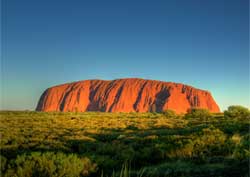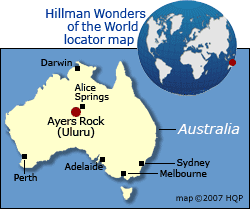Ayers Rock / Urulu
 Why
Ayers Rock
is special
Why
Ayers Rock
is specialThe icon of Australia is the world's second largest free standing monolith. Ayers Rock rises solitarily 348 meters (1141 feet) above the desert plain and is over 9 kilometers (5 miles) in circumference. It's also known for its sacredness and changing colors.
Official name
Uluru name
Ayers Rock's official appellation is Uluru, the one given by the Anunga Aborigines of Australia. Note: I use "Ayers Rock" in my website because it's far, far more recognized than "Urulu" by travelers around the world.
Think twice about visiting Ayers Rock in the height of Summer
Scorchingly hot
That's mid-December to mid-March in the southern hemisphere. Average midday temperatures are close to 38°C (100°F) and have soared as high as 45°C (113°F). Remember, you're in a desert.
Climbing Ayers Rock
Sacred
The rock is sacred to the local Anunga Aborigines.
Climbing
The Anungas discourage (but do not prohibit) visitors from climbing their sacred mountain. Roughly 1 out of 10 visitors do climb the rock, using an ancient Aborigine trail. A few slip and lose their lives each year. Once on top, the view is staggering. Note: The trail is closed when it is windy, rainy or excessively hot.
If you elect not to climb
There are several interesting ground level paths. One stretches completely around the monolith. An Aborigine guide will explain his culture's mythology relating to the rock and will show you rock paintings.
Tips & insights on Ayers Rock
Best times of the day
Ayers Rock is at its visual best at sunrise and sunset.
Geology
The monolith is sandstone, the product of layers of sand laid down in an ancient sea bed about 500 million years ago.
Ayers Rock name
Ayers Rock is the popular English designation (named after Sir Henry Ayers, a 19th century Australian governor).
Compared to Mt. Augustus
Although Ayers Rock is less than half the size of the world's largest monolith (Mt. Augustus in Western Australia), it has a more dramatic shape and overall appearance.
Sits deep into the ground
Ayers Rock is like an iceberg because only its tip is visible - the rest extends deep into the ground.
Varying hues
The rock's surface conspicuously changes colors as the day passes - and according to weather conditions, your distance from it, and your viewing angle. Hues include reds, oranges, yellows, and grays.
Caves
The monolith is pock-marked with small caves - see black dots on the photo above.
Remote
Ayers Rock is in the middle of Australia in the middle of nowhere. The nearest modest-sized city (Alice Springs) is nearly 500 kilometers (300 miles) away.
Nearby wonders
If you base yourself in Alice Springs, you can make sort of a loop visiting three of my Hillman Wonder medal winners in Australia:
-
Ayers Rock
Gold medal
- Kings Canyon
Bronze Medal
- The Olgas
Bronze Medal
Location in Australia



